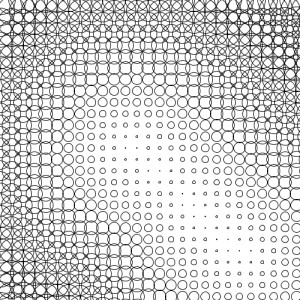Lesson 3.1 – Multiple Reactor Points
Multiple Reactor Points

ArrayList<PVector> reactorList = new ArrayList<PVector>();
int maxPointCount = 20;
int gridWidth = 30;
int gridHeight = 30;
float shapeWidth = 19;
float shapeHeight = 19;
float reactorScaler = .008;
void setup() {
size(500,500);
smooth();
}
void draw() {
background(255);
PVector temp = new PVector(mouseX,mouseY);
reactorList.add(temp);
if (reactorList.size() >= maxPointCount) {
reactorList.remove(0);
}
drawGeometry();
}
void drawGeometry() {
// unconment to see the trail of reactors created by mouse movement
//stroke(255,0,0);
// for(int i = 0; i <reactorList.size()-1; i++) {
// line(reactorList.get(i).x,reactorList.get(i).y, reactorList.get(i+1).x, reactorList.get(i+1).y);
// }
stroke(0);
noFill();
for(int i = 0; i<gridWidth; i++ ) {
for(int j = 0; j<gridHeight; j++ ) {
PVector myPos = new PVector(i*shapeWidth, j*shapeHeight);
PVector cpt = closestPoint(myPos);
float reactorDistance = dist(cpt.x, cpt.y, myPos.x, myPos.y);
float scaler = reactorDistance*reactorScaler;
ellipse(myPos.x, myPos.y, shapeWidth*scaler, shapeHeight*scaler);
};
};
}
PVector closestPoint(PVector location) {
PVector tempPoint = reactorList.get(0);
float bestDistance = dist(tempPoint.x,tempPoint.y,location.x,location.y);
for (int i = 0; i < reactorList.size(); i++) {
float tempDistance = dist(reactorList.get(i).x,reactorList.get(i).y,location.x,location.y);
if (tempDistance<bestDistance) {
bestDistance = tempDistance;
tempPoint = reactorList.get(i).get();
}
}
return tempPoint;
}
Exercise: Create a new examples using this principle by modifying the code with different geometric forms. Try rotation, colour change or deformations, or combining it with elements from previous exercises
